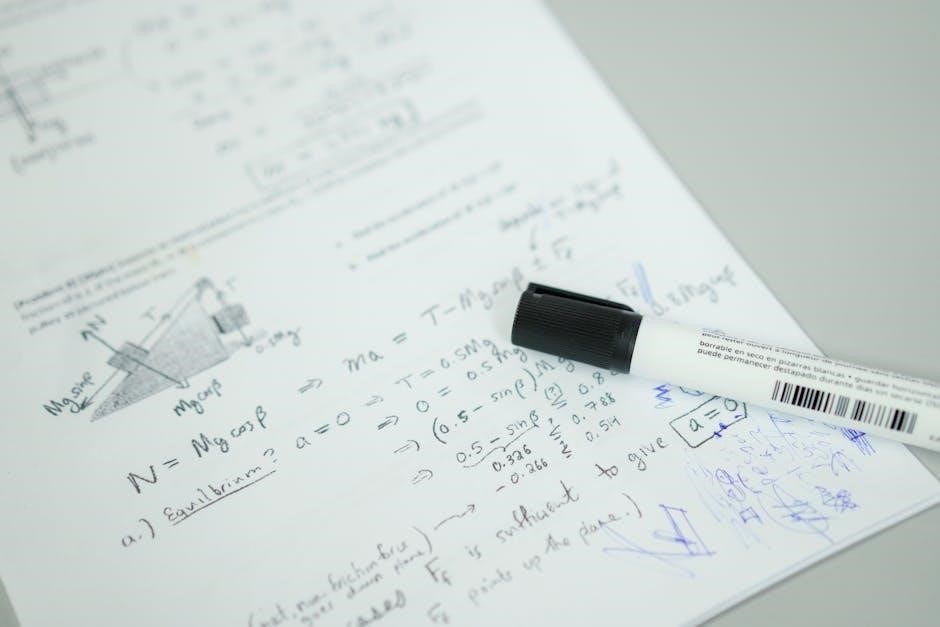Overview of the 10th Edition of “Fundamentals of Physics”
The 10th edition of “Fundamentals of Physics” by Halliday, Resnick, and Walker is a comprehensive textbook for calculus-based physics courses, offering enhanced problem-solving strategies, active learning tools, and multimedia resources to engage students and instructors alike.
The 10th edition of “Fundamentals of Physics” by Halliday, Resnick, and Walker introduces a comprehensive update to the classic textbook. Designed for calculus-based physics courses, it offers enhanced problem-solving strategies, multimedia resources, and a study guide. This edition emphasizes active learning, critical thinking, and practical applications, providing students with a robust foundation in physics concepts.
1.2 Key Features of the 10th Edition
The 10th edition features enhanced problem-solving strategies, interactive learning tools, and a robust integration of theoretical and practical applications. It includes multimedia resources, a study guide, and a solution manual. The textbook emphasizes active learning, critical thinking, and real-world applications, making it an essential resource for students and educators in calculus-based physics courses.
1.3 Authors and Their Contributions
David Halliday, Robert Resnick, and Jearl Walker are renowned physicists and educators. Their collaborative effort in the 10th edition ensures a balanced blend of theoretical depth and practical insight, making complex physics concepts accessible. Halliday’s clarity, Resnick’s problem-solving focus, and Walker’s modern applications collectively enhance the textbook’s effectiveness for both students and instructors in physics education.

Structure and Content of the Textbook
The 10th edition is structured to cover core physics concepts, organizing chapters logically from mechanics to modern physics. It integrates theoretical explanations with practical applications and multimedia tools to enhance understanding and engagement for students.
2.1 Organization of Chapters
The 10th edition is logically structured, with chapters progressing from foundational mechanics to advanced topics like thermodynamics, electromagnetism, and modern physics. Each chapter builds on previous concepts, ensuring a smooth learning curve. The textbook includes detailed problem sets and multimedia resources, enhancing comprehension and application of physics principles.
2.2 Coverage of Core Physics Concepts
The 10th edition thoroughly covers essential physics concepts, including mechanics, thermodynamics, electromagnetism, optics, and modern physics. It integrates theoretical explanations with practical applications, ensuring a deep understanding of fundamental principles. The textbook emphasizes problem-solving strategies and provides extensive practice problems, fostering analytical and quantitative reasoning skills in students.
2.3 Integration of Theoretical and Practical Applications
The 10th edition seamlessly integrates theoretical concepts with practical applications, providing real-world contexts for physics principles. This approach enhances students’ ability to connect abstract ideas to tangible scenarios, making learning more engaging and relevant. Multimedia resources and interactive tools further support this integration, offering a holistic understanding of physics in both academic and practical settings.

Key Features and Enhancements in the 10th Edition
The 10th edition features enhanced multimedia resources, interactive learning tools, and improved problem-solving strategies. It emphasizes active learning and critical thinking, providing students with a robust framework to master physics concepts effectively.
3.1 Multimedia Resources and Interactive Learning Tools
The 10th edition includes multimedia resources like interactive simulations, videos, and online quizzes. These tools enhance understanding and engagement, offering practical applications of physics concepts. Students can access these resources via PDF downloads or online platforms, making learning flexible and dynamic. Instructors also benefit from companion sites with presentation materials and assessment tools to support teaching.
3.2 Problem-Solving Strategies and Worked Examples
The 10th edition incorporates detailed problem-solving strategies and worked examples, guiding students through complex physics concepts. Each example breaks down problems into manageable steps, fostering analytical and quantitative reasoning. This approach helps students master fundamental principles and apply them to real-world scenarios effectively, enhancing their critical thinking and problem-solving skills in physics.
3.3 Emphasis on Active Learning and Critical Thinking
The 10th edition promotes active learning through interactive tools and real-world applications, encouraging students to engage deeply with physics concepts. It fosters critical thinking by integrating theoretical knowledge with practical problem-solving, enabling students to analyze complex scenarios and develop a robust understanding of fundamental principles.

Target Audience
The 10th edition of “Fundamentals of Physics” is designed for students in calculus-based physics courses, educators, engineers, and science majors, providing a comprehensive resource for learning and teaching physics.
4.1 Students in Calculus-Based Physics Courses
The 10th edition of “Fundamentals of Physics” is tailored for students in calculus-based physics courses, offering rigorous mathematical derivations, detailed problem sets, and multimedia resources to enhance understanding and engagement with complex physics concepts.
4.2 Educators and Instructors in Physics
The 10th edition supports educators with comprehensive resources, including an instructor companion site, test banks, and lecture notes, enabling effective lesson planning and delivery. It provides tools to assess student progress and foster a deeper understanding of physics concepts.
4.3 Engineers and Science Majors
The 10th edition is a vital resource for engineers and science majors, providing a robust foundation in core physics principles. It covers mechanics, thermodynamics, and electromagnetism with practical applications, making it ideal for students pursuing technical fields. The textbook’s emphasis on problem-solving and real-world scenarios prepares them for professional challenges in engineering and scientific research.

Supplementary Materials and Resources
The 10th edition offers a solution manual, test bank, and study guide, providing additional practice problems and resources for students and educators to enhance learning and assessment.
5.1 Solution Manual and Test Bank
The solution manual provides detailed answers to textbook problems, aiding students in understanding concepts. The test bank offers a variety of questions for instructors to assess student performance effectively, ensuring comprehensive coverage of topics and reinforcing learning outcomes through practice and evaluation.
5.2 Study Guide and Additional Practice Problems
The study guide complements the textbook with detailed explanations and worked examples, reinforcing key concepts. Additional practice problems are designed to challenge students, promoting a deeper understanding of physics principles. These resources cater to diverse learning styles, offering a comprehensive suite of tools to enhance problem-solving skills and conceptual clarity.
5.3 Instructor Companion Site and Online Tools
The instructor companion site offers a wealth of resources, including lecture notes, presentation materials, and assessment tools. These online tools provide educators with comprehensive support, enabling them to deliver engaging and effective physics instruction. The site also includes solutions manuals and additional teaching aids, fostering a dynamic and structured learning environment for both instructors and students.

Digital Availability and Accessibility
The 10th edition is available in PDF format, offering instant download and compatibility across various devices. This ensures easy access and flexibility for both students and educators.
6.1 PDF Format and Download Options
The 10th edition of “Fundamentals of Physics” is widely available in PDF format, enabling instant downloads and easy access. Compatible with various devices, the eBook ensures flexibility for students and educators. Additional resources, such as study guides and test banks, are also accessible for download, enhancing the learning experience.
6.2 Compatibility with Various Devices
The 10th edition of “Fundamentals of Physics” in PDF format is designed for seamless compatibility across multiple devices, including laptops, tablets, and smartphones. This ensures that students and educators can access the content effortlessly, anytime and anywhere, with optimal viewing experiences on various screen sizes and operating systems like iOS, Android, and Windows.
6.3 Instant Access to Educational Materials
The 10th edition of “Fundamentals of Physics” offers instant access to a wealth of educational materials, including the full textbook, interactive simulations, and supplementary resources. Students and instructors can download the PDF and additional tools directly, ensuring quick and convenient access to all necessary materials for learning and teaching.
Reviews and Ratings
The 10th edition of “Fundamentals of Physics” has received a 4.9/5 rating from over 2,500 reviews, praised by students and educators for its clarity and comprehensive coverage.
7.1 Student and Educator Feedback
Students and educators praise the 10th edition for its clarity and comprehensive coverage. Educators highlight its structured approach, while students appreciate the problem-solving strategies and interactive tools. The textbook’s integration of theoretical and practical applications enhances learning effectiveness, making it a preferred choice for calculus-based physics courses.
7.2 Comparison with Previous Editions
The 10th edition of “Fundamentals of Physics” builds upon earlier versions with enhanced multimedia tools, expanded problem sets, and improved pedagogical approaches. It introduces new features like the TEAL method, fostering deeper understanding and engagement. The updated content and modernized presentation set it apart, making it a significant upgrade for both students and instructors.
7.3 Market Reception and Popularity
The 10th edition of “Fundamentals of Physics” has received widespread acclaim, boasting a 4.9/5 rating from over 2,500 reviews. Its engaging features, comprehensive coverage, and enhanced learning tools have made it a bestseller. Educators and students alike praise its clarity and effectiveness, solidifying its position as a leading textbook in calculus-based physics education, widely adopted across universities globally.

Importance of Understanding Physics Fundamentals
Mastering physics fundamentals is essential for building a strong foundation in science and engineering, enabling students to tackle complex problems and apply concepts to real-world scenarios effectively.
8.1 Role of Physics in Science and Engineering
Physics serves as the foundation for all scientific and engineering disciplines, providing core principles and methodologies essential for understanding natural phenomena and developing innovative technologies. It enables advancements in fields like mechanics, thermodynamics, and electromagnetism, while its problem-solving approaches empower engineers and scientists to address real-world challenges effectively, making it indispensable for both academic and practical applications.
8.2 Building a Strong Foundation for Advanced Studies
Mastery of fundamental physics concepts is crucial for excelling in advanced studies and research. The textbook’s structured approach ensures a deep understanding of core principles, enabling students to tackle complex topics in specialized fields confidently. This solid foundation fosters analytical and critical thinking, preparing learners for graduate-level work and professional challenges in physics and engineering.
8.3 Practical Applications in Real-World Scenarios
The 10th edition emphasizes connecting physics principles to real-world applications, such as engineering, technology, and everyday phenomena. Chapters include examples illustrating how fundamental concepts solve practical problems, from energy systems to medical devices. This approach bridges theory and practice, preparing students to apply physics in diverse professional and scientific contexts effectively.

Chapter-Wise Breakdown
The 10th edition is organized into chapters covering core physics concepts, including mechanics, thermodynamics, electromagnetism, and optics. Each chapter provides detailed explanations and practical examples to build a strong foundation in physics.
9.1 Mechanics and Motion
The chapter on Mechanics and Motion introduces foundational principles such as kinematics, dynamics, and energy. It explores motion in one and two dimensions, circular motion, and the laws of Newton. Practical examples and problem sets help students understand and apply these concepts effectively, fostering a deep grasp of mechanical systems and their real-world applications.
9.2 Thermodynamics and Energy
This chapter delves into the principles of thermodynamics, energy conservation, and heat transfer. It covers the laws of thermodynamics, internal energy, entropy, and energy transformations. Practical examples and problems illustrate the application of these concepts in real-world scenarios, enabling students to grasp the fundamental relationships between heat, work, and energy in physical systems.
9.3 Electromagnetism and Optics
This chapter explores the fundamentals of electromagnetism, including electric and magnetic fields, induction, and Maxwell’s equations. It also delves into wave optics, interference, diffraction, and modern optical phenomena. Practical applications and detailed examples illustrate the behavior of light and electromagnetic waves, providing a solid understanding of these critical physics concepts and their real-world implications.

Problem Solving and Critical Thinking
The 10th edition emphasizes problem-solving strategies and critical thinking, integrating theoretical and practical knowledge through guided examples and multimedia tools to enhance analytical skills and real-world applications.
10.1 Strategies for Effective Problem Solving
The 10th edition provides structured strategies for effective problem solving, including the “Think, Express, Analyze, and Learn” (TEAL) approach. This method guides students through understanding concepts, applying principles, and verifying solutions, fostering a systematic and confident approach to tackling complex physics problems. Interactive tools and worked examples further enhance this learning process.
10.2 Analytical and Quantitative Reasoning
The 10th edition emphasizes analytical and quantitative reasoning by integrating theoretical concepts with practical problems. Students are guided to apply mathematical techniques and logical thinking to solve physics problems, fostering a deep understanding of principles and their real-world implications.
10.4 Application of Concepts in Real-World Problems
The 10th edition excels in applying physics concepts to real-world scenarios, bridging theory with practicality. Examples include energy conservation, electromagnetism in technology, and thermodynamics in engineering, enabling students to visualize and solve problems in authentic contexts, enhancing their ability to connect physics principles to everyday challenges and innovations.
Teaching and Learning Methods
The 10th edition employs innovative teaching methods, blending interactive tools, guided problems, and multimedia resources to foster a dynamic learning environment, enhancing student engagement and understanding.
11.1 Pedagogical Approaches in the Textbook
The textbook integrates diverse pedagogical strategies, including think-express-analyze-learn methods, interactive simulations, and real-world applications, promoting active learning and critical thinking while aligning with modern educational standards to enhance student comprehension and retention of complex physics concepts effectively.
11.2 Encouraging Student Engagement
The textbook employs interactive simulations, real-world applications, and problem-solving strategies to foster student engagement. Multimedia resources and worked examples encourage active participation, while practical exercises help students connect theoretical concepts to real-world scenarios, enhancing their interest and motivation in learning physics effectively;
11.3 Tools for Instructor Support
The 10th edition provides instructors with comprehensive resources, including an Instructor Solutions Manual, lecture notes, and presentation materials. The companion site offers assessment tools, test banks, and multimedia presentations, enabling educators to effectively manage and deliver calculus-based physics courses while supporting student learning and engagement.

Resources for Instructors
The 10th edition provides instructors with a Solution Manual, Test Bank, and online resources, assisting in curriculum management and enhancing teaching effectiveness for calculus-based physics courses.
12.1 Instructor Solutions Manual
The Instructor Solutions Manual for the 10th edition offers comprehensive solutions to textbook problems, aiding instructors in preparing assignments and assessments. It includes detailed explanations and answers, ensuring accuracy and consistency in teaching calculus-based physics concepts, aligned with the textbook’s content and pedagogical approach, supporting effective instruction and student understanding.
12.2 Lecture Notes and Presentation Materials
The 10th edition provides instructors with downloadable lecture notes and presentation materials, including slides and multimedia resources. These tools facilitate effective classroom delivery, covering key physics concepts and problem-solving strategies. They are designed to engage students and supplement the textbook, ensuring a cohesive and interactive learning experience for calculus-based physics courses.
12.3 Assessment and Evaluation Tools
The 10th edition offers a comprehensive test bank and assessment tools, enabling instructors to evaluate student understanding effectively. These resources include multiple-choice questions, numerical problems, and conceptual assessments, all aligned with the textbook’s content. They provide a robust framework for monitoring progress and ensuring mastery of physics fundamentals in a structured and efficient manner.

No Responses